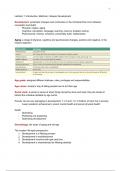Samenvatting
Summary of the first year course Developmental Psychology
- Instelling
- Tilburg University (UVT)
Detailed summary of the first year psychology course Developmental Psychology in Blok 4. This includes the lectures, slides, book and videos.
[Meer zien]





